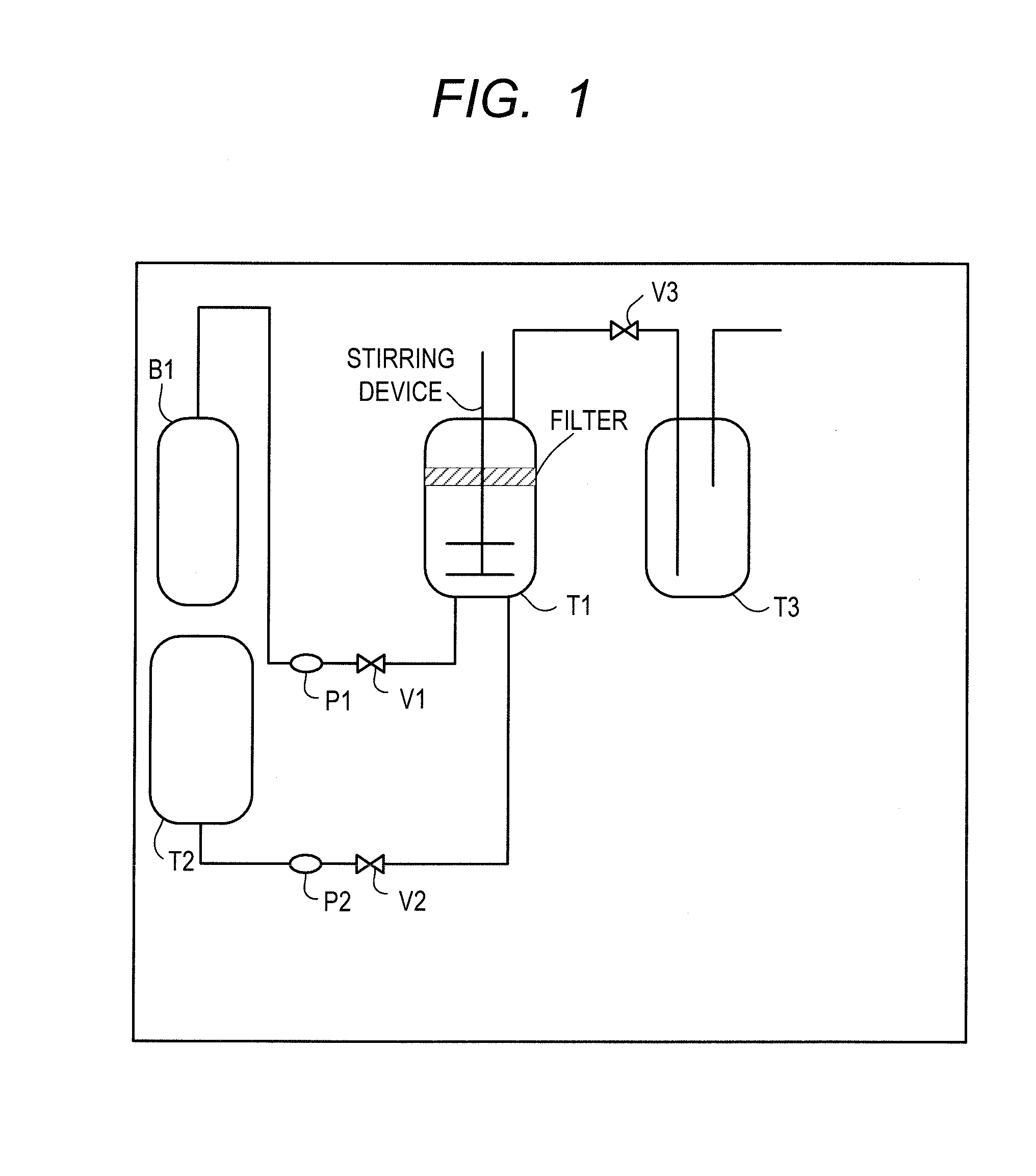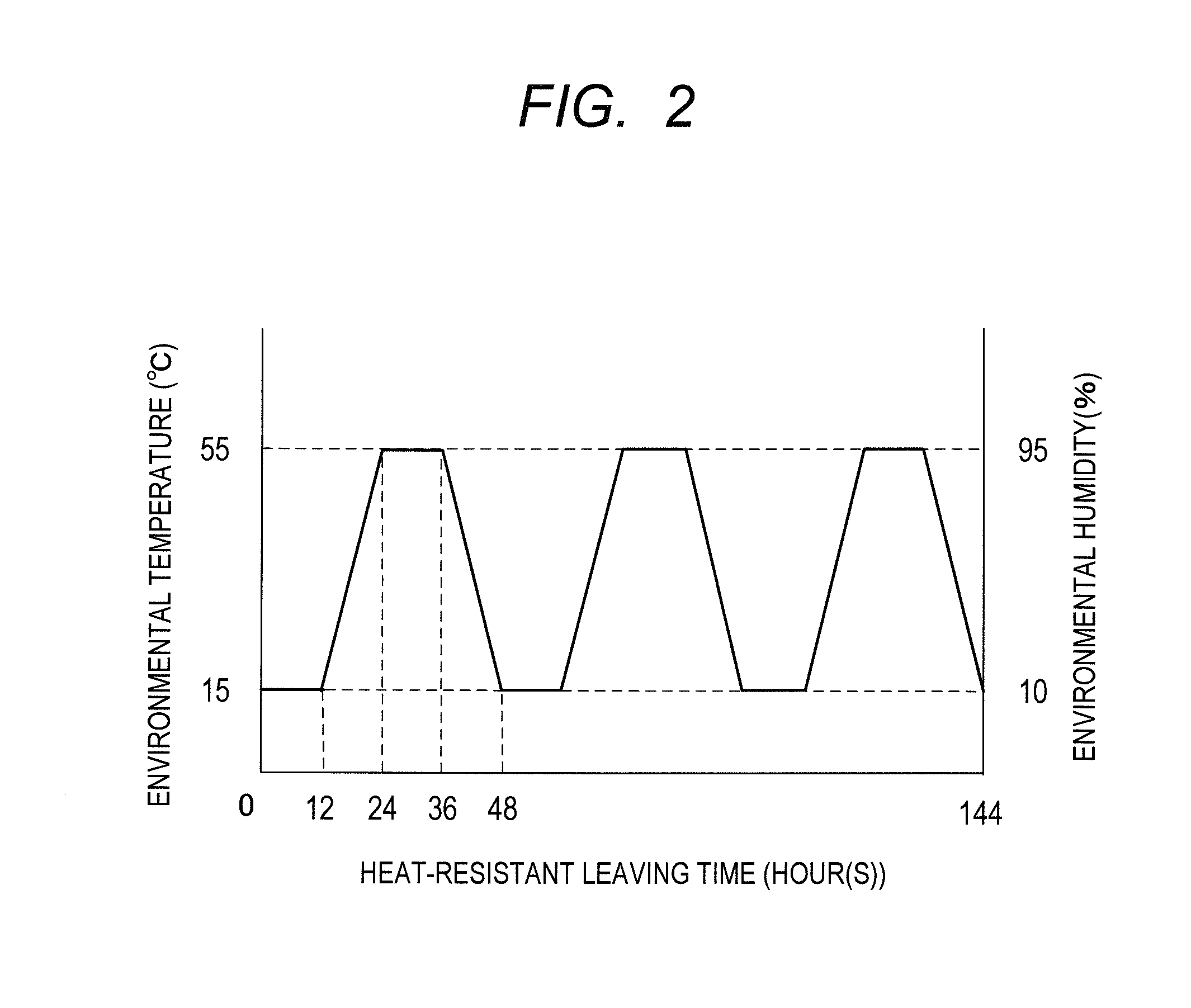Resin particle and method of producing the resin particle, and toner and method of producing the toner
a technology of resin particles and resin particles, which is applied in the direction of instruments, developers, optics, etc., can solve the problems of insufficient stability, inability to achieve sharp particle size distribution of toner, and inability to achieve sufficient stability, etc., and achieve excellent durability
- Summary
- Abstract
- Description
- Claims
- Application Information
AI Technical Summary
Benefits of technology
Problems solved by technology
Method used
Image
Examples
example 1
Production of Resin Particles 1
[0365]In an apparatus illustrated in FIG. 1, first, valves V1 and V2, and a pressure-adjusting valve V3 were closed. 18.0 Parts of the resin fine particle dispersion liquid 1 was loaded into a pressure-resistant granulation tank T1 including a filter for capturing resin particles and a stirring mechanism, and a temperature in the tank was adjusted to 25° C. Next, the valve V1 was opened, carbon dioxide (purity: 99.99%) was introduced from a carbon dioxide bomb B1 into the granulation tank T1 with a pump P1, and the valve V1 was closed when a pressure in the tank reached 2.0 MPa. Meanwhile, the resin solution 1 was loaded into a resin solution tank T2 and a temperature in the tank was adjusted to 25° C.
[0366]Next, the valve V2 was opened, and while the contents in the granulation tank T1 were stirred at 2,000 rpm, the contents in the resin solution tank T2 were introduced into the granulation tank T1 with a pump P2. When the introduction of all the cont...
example 6
Production of Toner Particles 1
[0373]In the apparatus illustrated in FIG. 1, first, the valves V1 and V2, and the pressure-adjusting valve V3 were closed. 18.0 Parts of the resin fine particle dispersion liquid 1 was loaded into the pressure-resistant granulation tank T1 including a filter for capturing toner particles and a stirring mechanism, and a temperature in the tank was adjusted to 40° C. Next, the valve V1 was opened, carbon dioxide (purity: 99.99%) was introduced from the carbon dioxide bomb B1 into the granulation tank T1 with the pump P1, and the valve V1 was closed when a pressure in the tank reached 2.0 MPa. Meanwhile, the resin solution 1, the wax dispersion liquid 1, and the colorant dispersion liquid 1 were loaded into the resin solution tank T2 and a temperature in the tank was adjusted to 40° C.
[0374]Next, the valve V2 was opened, and while the contents in the granulation tank T1 were stirred at 2,000 rpm, the contents in the resin solution tank T2 were introduced...
example 32
Production of Toner Particles 27
[0383]
Resin solution 5100.0 parts by massWax dispersion liquid 2 10.0 parts by massColorant dispersion liquid 2 6.0 parts by mass
[0384]The foregoing materials were loaded into a container, and were stirred and dispersed with HOMODISPER (manufactured by Tokushu Kika Kogyo Co., Ltd.) at 1,500 rpm for 10 minutes. Further, the resultant solution was dispersed under normal temperature with an ultrasonic dispersing machine for 30 minutes. Thus, an oil phase 1 was prepared.
Resin fine particle dispersion liquid 2718.0 parts by massAqueous solution of 50% sodium dodecyl15.0 parts by massdiphenyl ether disulfonate (ELEMINOL MON-7,Sanyo Chemical Industries, Ltd.)Aqueous solution of 1 mass %50.0 parts by masscarboxymethylcellulosePropylamine (Kanto Chemical Co., Inc.) 2.5 parts by massIon-exchanged water200.0 parts by mass Ethyl acetate (organic solvent)10.0 parts by mass
[0385]The foregoing materials were loaded into a container, and were stirred with T.K. Homomi...
PUM
 Login to View More
Login to View More Abstract
Description
Claims
Application Information
 Login to View More
Login to View More - R&D
- Intellectual Property
- Life Sciences
- Materials
- Tech Scout
- Unparalleled Data Quality
- Higher Quality Content
- 60% Fewer Hallucinations
Browse by: Latest US Patents, China's latest patents, Technical Efficacy Thesaurus, Application Domain, Technology Topic, Popular Technical Reports.
© 2025 PatSnap. All rights reserved.Legal|Privacy policy|Modern Slavery Act Transparency Statement|Sitemap|About US| Contact US: help@patsnap.com



